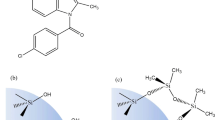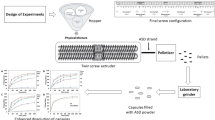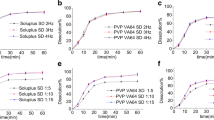Abstract
Purpose
Amorphous lurasidone hydrochloride (LH) showed decreased dissolution behavior in comparison to crystalline LH owing to gelation during dissolution as reported in our previous study. The current study aims to investigate external factors including temperature and ionic strength on the gelation and hence the dissolution of amorphous LH.
Methods
Dissolution tests of amorphous LH were performed under different temperatures and buffer ionic strengths. The formed gels were characterized by rheology study, texture analysis, PLM, SEM, DSC, XRPD and FTIR.
Results
With the increase of temperature and ionic strength of medium, the dissolution of amorphous LH decreased, while the strength, hardness and adhesiveness of in situ formed gel enhanced. Amorphous LH converted into its crystalline state during dissolution and the crystallization rate was affected by medium conditions. With medium temperature increasing from 30°C to 45°C, the gel microstructure changed from interconnecting fibrillar network to spherical particle aggregate. On the other hand, the formed spherulitic gel aggregate exhibited increased particle size when increasing the ionic strength of medium.
Conclusions
With increase of temperature and ionic strength, the gel strength of in situ formed gel from amorphous LH enhanced with more compact microstructure, subsequently leading to decreased dissolution profiles.













Similar content being viewed by others
Abbreviations
- BCS:
-
Biopharmaceutics Classification System
- DSC:
-
Differential scanning calorimetry
- FTIR:
-
Fourier transform infrared spectroscopy
- HPMC:
-
Hydroxypropyl methylcellulose
- LH:
-
Lurasidone hydrochloride
- PLM:
-
Polarized light microscopy
- SEM:
-
Scanning electron microscopy
- XRPD:
-
X-ray powder diffraction
Rererences
Di L, Fish PV, Mano T. Bridging solubility between drug discovery and development. Drug Discov Today. 2012;17(9–10):486–95.
Engers D, Teng J, Jimenez-Novoa J, Gent P, Hossack S, Campbell C, et al. A solid-state approach to enable early development compounds: selection and animal bioavailability studies of an itraconazole amorphous solid dispersion. J Pharm Sci. 2010;99(9):3901–22.
Jójárt-Laczkovich O, Szabó-Révész P. Amorphization of a crystalline active pharmaceutical ingredient and thermoanalytical measurements on this glassy form. J Therm Anal Calorim. 2010;102(1):243–7.
Yu L. Amorphous pharmaceutical solids: preparation, characterization and stabilization. Adv Drug Deliv Rev. 2001;48(1):27–42.
Zhang K, Yu H, Luo Q, Yang S, Lin X, Zhang Y, et al. Increased dissolution and oral absorption of itraconazole/Soluplus extrudate compared with itraconazole nanosuspension. Eur J Pharm Biopharm. 2013;85(3 Pt B):1285–92.
Alonzo DE, Zhang GG, Zhou D, Gao Y, Taylor LS. Understanding the behavior of amorphous pharmaceutical systems during dissolution. Pharm Res. 2010;27(4):608–18.
Hancock BC, Parks M. What is the true solubility advantage for amorphous pharmaceuticals? Pharm Res. 2000;17(4):397–404.
Chawla G, Bansal AK. A comparative assessment of solubility advantage from glassy and crystalline forms of a water-insoluble drug. Eur J Pharm Sci. 2007;32(1):45–57.
Kim JS, Kim MS, Park HJ, Jin SJ, Lee S, Hwang SJ. Physicochemical properties and oral bioavailability of amorphous atorvastatin hemi-calcium using spray-drying and SAS process. Int J Pharm. 2008;359(1–2):211–9.
Zhao QF, Wang TY, Wang J, Zheng L, Jiang TY, Cheng G, et al. Template-directed hydrothermal synthesis of hydroxyapatite as a drug delivery system for the poorly water-soluble drug carvedilol. Appl Surf Sci. 2011;257(23):10126–10,133.
Hamaura T, Kusai A, Nishimura K. Gel formation of cefpodoxime proxetil. Stp Pharma Sci. 1995;5(4):324–31.
Law D, Krill SL, Schmitt EA, Fort JJ, Qiu Y, Wang W, et al. Physicochemical considerations in the preparation of amorphous ritonavir-poly(ethylene glycol) 8000 solid dispersions. J Pharm Sci. 2001;90(8):1015–25.
Meulenaar J, Beijnen JH, Schellens JH, Nuijen B. Slow dissolution behaviour of amorphous capecitabine. Int J Pharm. 2013;441(1–2):213–7.
Fujiki S, Iwao Y, Kobayashi M, Miyagishima A, Itai S. Stabilization mechanism of clarithromycin tablets under gastric pH conditions. Chem Pharm Bull. 2011;59(5):553–8.
Noguchi S, Takiyama K, Fujiki S, Iwao Y, Miura K, Itai S. Polymorphic transformation of antibiotic clarithromycin under acidic condition. J Pharm Sci. 2014;103(2):580–6.
Inukai K, Takiyama K, Noguchi S, Iwao Y, Itai S. Effect of gel formation on the dissolution behavior of clarithromycin tablets. Int J Pharm. 2017;521(1–2):33–9.
Furitsu H, Suzuki Y. Composition medicamenteuse. 2006. WO2006030826A1.
Pang Z, Wei Y, Wang N, Zhang J, Gao Y, Qian S. Gel formation of puerarin and mechanistic study during its cooling process. Int J Pharm. 2018;548(1):625–35.
Xing B, Yu CW, Chow KH, Ho PL, Fu D, Xu B. Hydrophobic interaction and hydrogen bonding cooperatively confer a vancomycin hydrogel: a potential candidate for biomaterials. J Am Chem Soc. 2002;124(50):14846–14,847.
Flory PJ. Introductory lecture. Faraday Discuss Chem Soc. 1974;57(5):7–18.
Tanaka T. Gels Sci Am. 1981;244(1):124–36 138.
Terech P, Wade RH. The relationship between a dried and native steroid gel. J Colloid Interface Sci. 1988;125:542–51.
Schott H. Kinetics of swelling of polymers and their gels. J Pharm Sci. 1992;81(5):467–70.
Kristl J, Smidkorbar J, Struc E, Schara M, Rupprecht H. Hydrocolloids and gels of chitosan as drug carriers. Int J Pharm. 1993;99(1):13–9.
Hayakawa E, Furuya K, Kuroda T, Moriyama M, Kondo A. Studies on the dissolution behavior of doxorubicin hydrochloride freeze-dried product. Chem Pharm Bull. 1990;38(12):3434–9.
George M, Weiss RG. Molecular organogels. Soft matter comprised of low-molecular-mass organic gelators and organic liquids. Acc Chem Res. 2006;39(8):489–97.
Terech P, Weiss RG. Low molecular mass gelators of organic liquids and the properties of their gels. Chem Rev. 1997;97(8):3133–59.
Qian S, Wang S, Li Z, Wang X, Ma D, Liang S, et al. Charge-assisted bond N(+)H mediates the gelation of amorphous lurasidone hydrochloride during dissolution. Int J Pharm. 2017;518(1–2):335–41.
Mittal A, Yadav M, Choudhary D, Shrivastava B. Enhancement of solubility of lurasidone HCl using solid dispersion technique. Int J Res Ayurveda Pharm. 2014;5(5):632–7.
Sanford M. Lurasidone: in the treatment of schizophrenia. CNS Drugs. 2013;27(1):67–80.
Lee KR, Chae YJ, Koo TS. Pharmacokinetics of lurasidone, a novel atypical anti-psychotic drug, in rats. Xenobiotica. 2011;41(12):1100–7.
Qian S, Heng W, Wei Y, Zhang J, Gao Y. Coamorphous lurasidone hydrochloride-saccharin with charge-assisted hydrogen bonding interaction shows improved physical stability and enhanced dissolution with pH-independent solubility behavior. Cryst Growth Des. 2015;15(6):2920–8.
Qian S, Li Z, Heng W, Liang S, Ma D, Gao Y, et al. Charge-assisted intermolecular hydrogen bond formed in coamorphous system is important to relieve the pH-dependent solubility behavior of lurasidone hydrochloride. RSC Adv. 2016;6(108):106396–106,412.
Treptow RS. Le Châtelier’s principle applied to the temperature dependence of solubility. J Chem Educ. 1984;61(6):499–502.
Imaizumi H, Nambu N, Nagai T. Stability and several physical properties of amorphous and crystalline forms of indomethacin. Chem Pharm Bull. 1980;28(9):2565–9.
Sato T, Okada A, Sekiguchi K, Tsuda Y. Difference in physico-pharmaceutical properties between crystalline and non crystalline 9,3″-diacetylmidecamycin. Chem Pharm Bull. 1981;29(9):2675–82.
Babu JS, Mondal C, Sengupta S, Karmakar S. Excess vibrational density of states and the brittle to ductile transition in crystalline and amorphous solids. Soft Matter. 2016;12(4):1210–8.
Lau KC, Dunlap BI. Molecular dynamics simulation of yttria-stabilized zirconia (YSZ) crystalline and amorphous solids. J Phys Condens Matter. 2011;23(3).
Hancock BC, Zograf G. Characteristics and significance of the amorphous state in pharmaceutical systems. J Pharm Sci. 1997;86(1):1–12.
Hancock BC, Zografi G. The relationship between the glass-transition temperature and the water-content of amorphous pharmaceutical solids. Pharm Res. 1994;11(4):471–7.
Andronis V, Zografi G. Molecular mobility of supercooled amorphous indomethacin, determined by dynamic mechanical analysis. Pharm Res. 1997;14(4):410–4.
Collins KD. Charge density-dependent strength of hydration and biological structure. Biophys J. 1997;72(1):65–76.
Asare-Addo K, Conway BR, Larhrib H, Levina M, Rajabi-Siahboomi AR, Tetteh J, et al. The effect of pH and ionic strength of dissolution media on in-vitro release of two model drugs of different solubilities from HPMC matrices. Colloids Surf B: Biointerfaces. 2013;111:384–91.
Porumb H. The solution spectroscopy of drugs and the drug-nucleic acid interactions. Prog Biophys Mol Biol. 1978;34(3):175–95.
Peddireddy KR, Capron I, Nicolai T, Benyahia L. Gelation kinetics and network structure of cellulose nanocrystals in aqueous solution. Biomacromolecules. 2016;17(10):3298–304.
Hayakawa E, Furuya K, Ueno H, Kuroda T, Moriyama M, Kondo A. Visible absorption and proton nuclear magnetic resonance studies on the self-association of doxorubicin in aqueous solution. Chem Pharm Bull. 1991;39(4):1009–12.
Wang L, Shi X, Wang J. A temperature-responsive supramolecular hydrogel: preparation, gel-gel transition and molecular aggregation. Soft Matter. 2018;14(16):3090–5.
Liu XY, Sawant PD. Mechanism of the formation of self-organized microstructures in soft functional materials. Adv Mater. 2002;14(6):421–6.
Lau MH, Tang J, Paulson AT. Texture profile and turbidity of gellan/gelatin mixed gels. Food Res Int. 2000;33(8):665–71.
Huang M, Kennedy JF, Li B, Xu X, Xie BJ. Characters of rice starch gel modified by gellan, carrageenan, and glucomannan: A texture profile analysis study. Carbohydr Polym. 2007;69(3):411–8.
Sanderson GR. Gellan gum. In: Harris P, editor. Food gels. New York, USA: Elsevier; 1990. p. 201–32.
Wolf CL, Beach S, LaVelle WM, Clark RC. Gellan gum/gelation blends. 1989. US4876105.
Yoshioka M, Hancock BC, Zografi G. Crystallization of indomethacin from the amorphous state below and above its glass transition temperature. J Pharm Sci. 1994;83(12):1700–5.
Wang R, Liu XY, Xiong J, Li J. Real-time observation of fiber network formation in molecular organogel: supersaturation-dependent microstructure and its related rheological property. J Phys Chem B. 2006;110(14):7275–80.
Liu XY, Sawant PD, Tan WB, Noor IB, Pramesti C, Chen BH. Creating new supramolecular materials by architecture of three-dimensional nanocrystal fiber networks. J Am Chem Soc. 2002;124(50):15055–15,063.
Wang RY, Liu XY, Narayanan J, Xiong JY, Li JL. Architecture of fiber network: from understanding to engineering of molecular gels. J Phys Chem B. 2006;110(51):25797–25,802.
Okubo T, Tsuchida A, Kato T. Nucleation and growth processes in the colloidal crystallization of silica spheres in the presence of sodium chloride as studied by reflection spectroscopy. Colloid Polym Sci. 1999;277(2–3):191–6.
Bhamidi V, Skrzypczak-Jankun E, Schall CA. Dependence of nucleation kinetics and crystal morphology of a model protein system on ionic strength. J Cryst Growth. 2001;232(1–4):77–85.
Cerdeira M, Puppo MC, Martini S, Herrera ML. Effects of salts on crystallization kinetics and rheological behavior of concentrated alpha,alpha-trehalose solutions. J Food Sci. 2003;68(9):2644–50.
Longinotti MP, Mazzobre MF, Buera MP, Corti HR. Effect of salts on the properties of aqueous sugar systems in relation to biomaterial stabilization - Part 2. Sugar crystallization rate and electrical conductivity behavior. Phys Chem Chem Phys. 2002;4(3):533–40.
Grinshtein J, Frydman L. Solid state separated-local-field NMR spectroscopy on half-integer quadrupolar nuclei: principles and applications to borane analysis. J Am Chem Soc. 2003;125(24):7451–60.
Heinz A, Strachan CJ, Gordon KC, Rades T. Analysis of solid-state transformations of pharmaceutical compounds using vibrational spectroscopy. J Pharm Pharmacol. 2009;61(8):971–88.
Talor LS, Zhang GGZ. Physical chemistry of supersaturated solutions and implications for oral absorption. Adv Drug Deliv Rev. 2016;101:122–42.
Gao Y, Gesenberg C, Zheng W. Oral formulations for preclinical studies: principle, design, and development considerations. In: Qiu Y, Chen Y, Zhang GGZ, Yu L, Mantri RV, editors. Developing solid oral dosage forms: pharmaceutical theory and practice. London: Academic Press; 2017. p. 455–95.
Raina SA, Zhang GGZ, Alonzo DE, Wu J, Zhu D, Catron ND, et al. Enhancements and limits in drug membrane transport using supersaturated solutions of poorly water soluble drugs. J Pharm Sci. 2014;103:2736–48.
Van Eerdenbrugh B, Raina S, Hsieh Y-L, Augustijns P, Taylor L. Classification of the crystallization behavior of amorphous active pharmaceutical ingredients in aqueous environments. Pharm Res. 2014;31:969–82.
Estroff LA, Hamilton AD. Water gelation by small organic molecules. Chem Rev. 2004;104(3):1201–17.
ACKNOWLEDGMENTS AND DISCLOSURES
This research was supported by National Natural Science Foundation of China (81,703,712, 81,773,675, 81,873,012), “Double First-Class” University Project (CPU2018GY11, CPU2018GY27), Top-notch Academic Programs Project of Jiangsu Higher Education Institutions (TAPP), Priority Academic Program Development of Jiangsu Higher Education Institutions (PAPD), Jiangsu Province Double Innovation Talent Program (2015), Postgraduate Research & Practice Innovation Program of Jiangsu Province. The authors declare no competing financial interest.
Author information
Authors and Affiliations
Corresponding authors
Additional information
Publisher’s Note
Springer Nature remains neutral with regard to jurisdictional claims in published maps and institutional affiliations.
Electronic supplementary material
ESM 1
(DOCX 606 kb)
Rights and permissions
About this article
Cite this article
Heng, W., Wei, Y., Zhou, S. et al. Effects of Temperature and Ionic Strength of Dissolution Medium on the Gelation of Amorphous Lurasidone Hydrochloride. Pharm Res 36, 72 (2019). https://doi.org/10.1007/s11095-019-2611-x
Received:
Accepted:
Published:
DOI: https://doi.org/10.1007/s11095-019-2611-x




